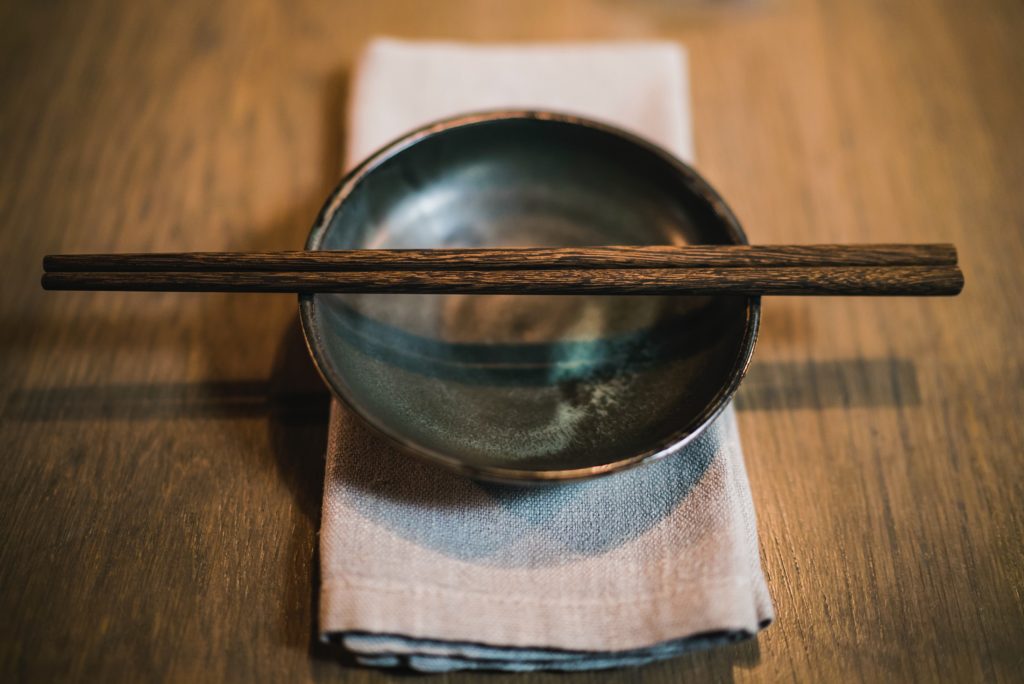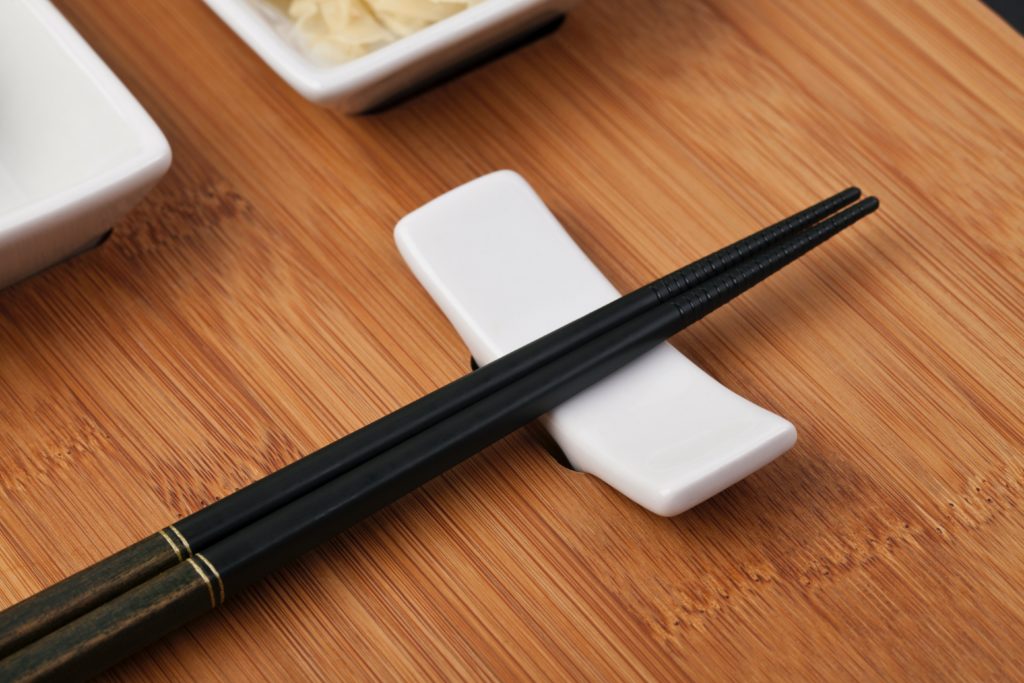When I was growing up in the ’90s and early 2000’s, my family ate exclusively with regular silverware — no chopsticks. The first time that someone at our table tried them out? My dad looked like he’d just seen an alien attack (or maybe Ewok).
For years after that awkward experience, I didn’t quite get what all the fuss was about. But then one day I found myself seated next to a Chinese food delivery person who handed me two small sticks. It felt weirdly natural; I picked them up and started eating. And now, I’m hooked.
I’ve been using chopsticks ever since — not only because they look cool, but also because they allow me to eat delicious Asian foods without getting sick from stomach-churning MSG or ingesting way too much sodium. They make dining so easy! If you haven’t given chopsticks a try yet, give these tips some love and see how well they work for you. You may never go back to forks and spoons again — unless your parents force feed you those things when you visit their home country.

1) Chopsticks are meant to be used together.
“The most important thing to remember is that chopsticks should always be eaten together,” says Rachel Nguyen, author of “Unf*ck Your Fave’s Guide to Dating Men Across Cultures.” “That means if there are multiple people at the same dinner party, everyone will have to share chopsticks.”
If you take a bite off a stick on its own, you may accidentally drop it into other dishes. Plus, since chopsticks come in pairs, sharing makes sense. One person holds one end while another person uses the opposite end. This allows each diner to keep track of their individual serving utensils easily — instead of having to constantly fish around looking for lost sticks.
2) Don’t stab your friends’ food with your chopsticks. That’s rude.
You don’t want to play chicken with your date by stabbing his noodles with them mid-bite. Not only does this hurt feelings, it could cause serious injury.
3) Use your middle finger to pick up pieces of food.
This tip comes courtesy of chef David Chiang, cofounder of NYC restaurant Eve & Vine. He explains via email that picking up food with your pinkie can lead to hand cramps, which isn’t good during cold season. Using your middle finger prevents any potential issues.
4) Remember to close your fist before grabbing something with your chopsticks.
It might seem counterintuitive, but closing your fingers tightly helps prevent dropping anything you grab with your hands. After all, your fingers won’t be able to grip something properly if they aren’t closed.
5) Keep your chopsticks straight.
In many cultures, including China, Korea, Japan, Vietnam, and Thailand, chopping wood involves holding a pair of chopsticks upright. When doing so, it’s customary to rest one handle against your chest plate. In addition, according to Chiang, Korean families often sit cross legged while eating at mealtime. Keeping your legs crossed while sitting upright gives you enough room to move freely with your chopsticks.
6) Grip your chopsticks correctly – How to use chopsticks properly
Your palms shouldn’t face forward. Instead, point your palms toward the ceiling. This ensures that your wrist remains steady as you hold objects with both hands. Also, avoid gripping your chopsticks loosely — it creates unnecessary stress on your arms. To help maintain proper posture throughout meals, keep your shoulder relaxed.
7) Hold your chopsticks horizontally.
Don’t do this. Holding your chopsticks vertically forces your body to bend over awkwardly, causing strain on your neck and shoulders.
8) Be mindful of where your chopsticks land.
According to Chiang, Koreans prefer their chopsticks touch the bowl lightly rather than landing directly on top of their food. Doing so keeps bacteria away from your dish.
9) Learn how to tell apart different types of rice.
Different countries serve various grains differently when preparing porridge. For example, Japanese restaurants typically prepare sushi rolls with brown rice, whereas South American eateries serve white rice inside corn tortillas. Knowing whether your meal contains white rice, black rice, or brown rice will save you from choking on a grain you weren’t expecting.
10) Know how to say thank you with chopsticks. – How to use chopsticks culturally
Yes, saying thank you with chopsticks sounds kind of silly. However, it’s actually pretty common among Asians. According to Nguyen, people commonly bow or offer a slight nod with their heads while thanking others for gifts received. So even though it seems odd, learning how to politely bow with chopsticks is a must.

11) Practice patience when waiting for your food to cook.
Waiting 20 minutes for soup to boil doesn’t sound very fun. However, once the water starts boiling, it takes approximately five minutes to bring it to a rolling boil. While this may appear lengthy, keep in mind that everything cooks simultaneously. So, instead of checking every few minutes, focus on enjoying your surroundings until your food eventually arrives.
12) Respect the rules of chopsticks etiquette.
No matter how long you’ve been using them, it’s still considered bad manners to slurp soup through a straw. Nor should you dip sauces such as soy sauce onto your rice. A better option would be to pour sauces evenly over your entire dish. At least that’ll ensure you don’t miss any spots.
13) Never steal someone else’s food.
This goes double if it’s a loved one. Though it may feel nice to partake in someone else’s delicacy, stealing from others shows disrespect. So leave a little bit behind and enjoy your meal responsibly.
14) Mindfully consume alcohol.
Drinking alcoholic beverages can throw your chopsticks off balance. As a result, it’s best to slowly sip on drinks as opposed to chugging them quickly. Otherwise, it’s possible to lose control and knock your drink right across the table.
15) Don’t lick your chopsticks clean.
While licking your chopsticks may feel satisfying, it could potentially spread germs and bacteria between diners.
16) Watch your salt intake.
Salt can damage your health, especially if taken excessively. Even though it tastes great, consuming more than 1 teaspoon of sodium per day puts you at risk of developing high blood pressure, heart disease, kidney stones, osteoporosis, etc. Stick to smaller amounts of salt whenever possible.
17) Eat vegetables whole.
Unless you’re trying to extract the pulp from a fruit, you probably know by now that cutting fruits and veggies with knives leads to mushy messes. Cutting tiny chunks with a knife requires excessive effort and causes undue waste. Save yourself trouble and learn how to spear a vegetable with chopsticks instead.
18) Always ask for additional sauces.
Though it may require extra effort, asking for more dipping sauces provides you with options. You never know when a sauce may taste amazing alone, but be overwhelmed with flavors when paired with certain ingredients. Additionally, requesting sauces lets you decide exactly how spicy you want your dish to be.
19) Try new things with chopsticks.
As mentioned earlier, I grew up thinking chopsticks were a gimmick. Once I learned how versatile they truly are, I became obsessed with trying new recipes with them. Nowadays, I mostly use them to mix ingredients within a stir fry, or occasionally cut meat. There really is nothing stopping you from experimenting with chopsticks beyond traditional cuisine. Just follow basic guidelines listed above and find inspiration somewhere. Who knows, you may discover your passion along the way.
20) Don’t worry too much about breaking them.
Like forks, chopsticks tend to break. However, unlike with forks, it happens frequently, making it less annoying. Nevertheless, broken chopsticks needn’t ruin your night. Simply replace them with fresh ones.
21) Clean chopsticks regularly.
If left unclean, dirty chopsticks can transfer dirt and grime from your mouth to whatever you place them upon. This can ultimately stain clothing and surfaces. Furthermore, keeping your chopsticks clean reduces bacterial growth.
22) Leave chopsticks standing upright.
Unlike forks, chopsticks stand upright by default. Therefore, it’s polite to let others finish eating before taking yours. Most importantly, don’t lay chopsticks parallel to the ground in order to hide them. This practice indicates you’re done eating and signals to everyone present that you’re finished.
23) Don’t leave chopsticks outside of food containers.
Clean chopsticks belong indoors. Placing them on windowsills increases chances for bugs and mold infestations. Rather than leaving them lying around, store them neatly in drawers or cabinets.
24) Avoid bending your chopsticks.
Bending your chopsticks unnaturally places added stress on them. Doing so can weaken or crack them prematurely.
25) Rinse chopsticks thoroughly.
Rinsing chopsticks removes residues from previous meals. Before placing them in storage or washing them later, rinse them under running water. Then dry them completely. Wipe excess moisture from

Leave a Reply